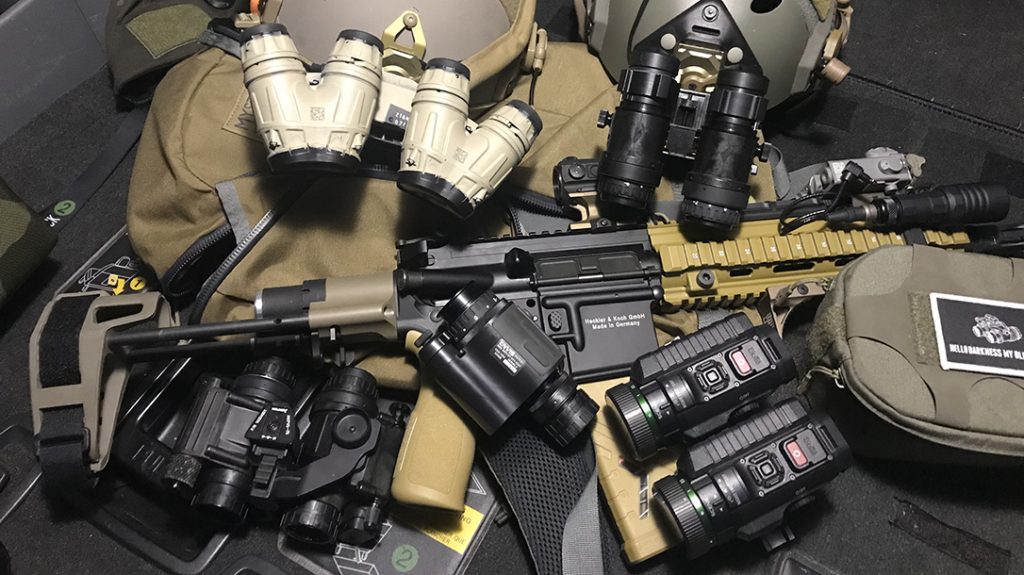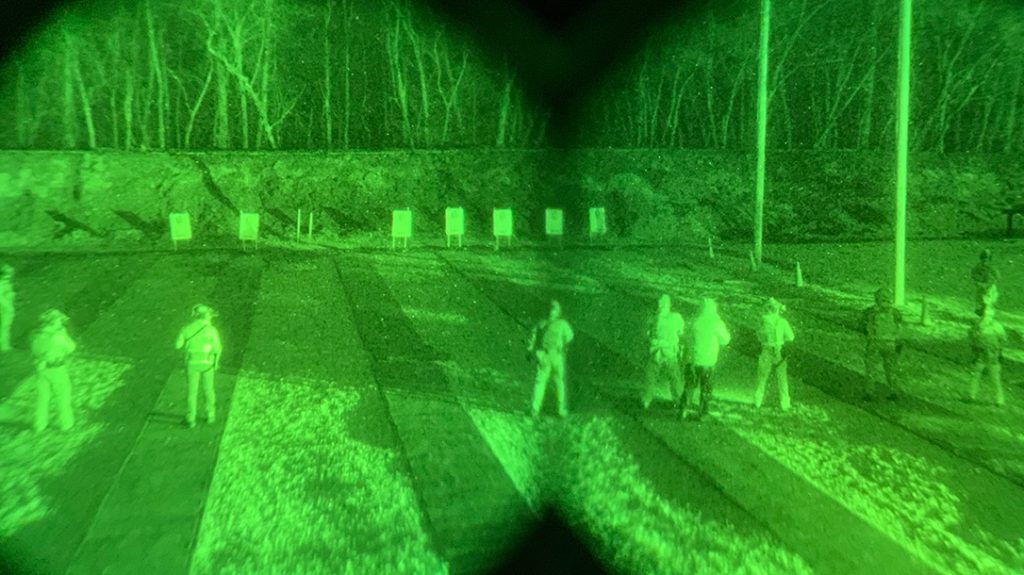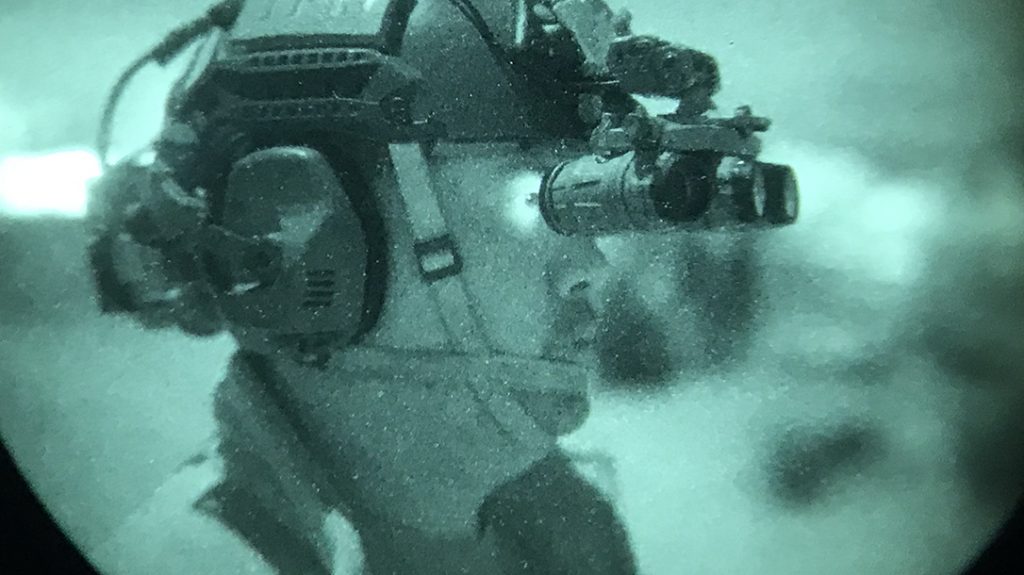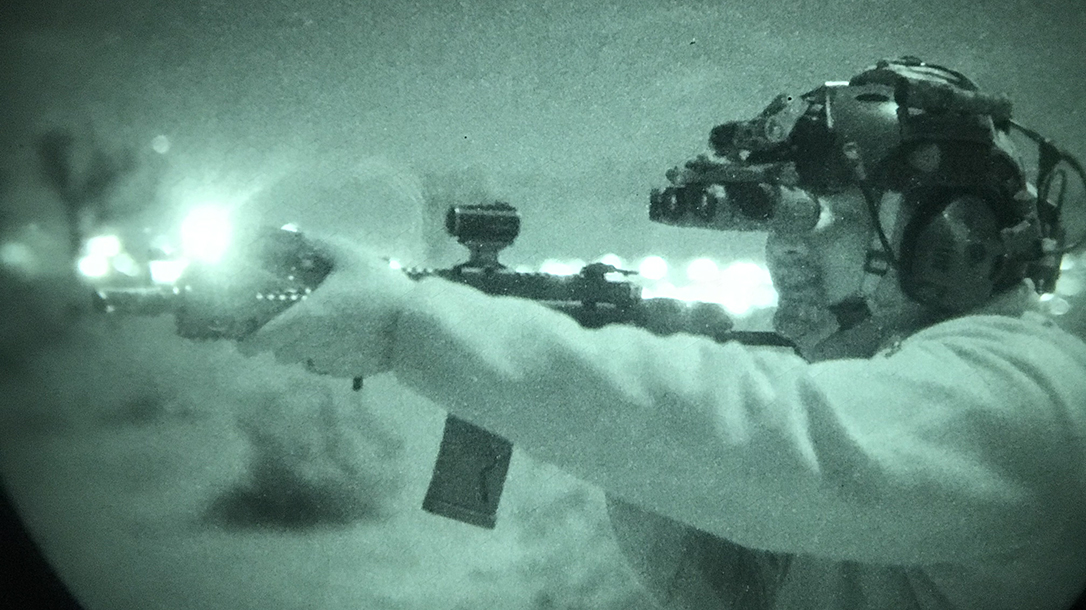So you want to get night vision. There are a lot of different devices out there, and the most common are worn on helmets. But even then, it’s not easy to decide on a model. Your choices are often limited by your budget, and night vision is typically expensive. While there are cheap options, anything under $1,000 isn’t worthwhile, and you’re better off using that money toward real night-vision equipment. That means Gen3 night vision, and the more tubes the device has, the more expensive it is. I will explore the pros and cons of having single-tube NODs vs. multiple-tube NODs.
Night Vision Basics
Beginners usually starts with a PVS-14 or PVS-7. Both use a single tube, but the PVS-7 splits the image into two eyepieces, whereas the PVS-14 only has a single eyepiece. For some, the PVS-7 looks better than a single monocular like the PVS-14. When I tried a PVS-7 for the first time, I had already spent a year using a PVS-14, so I was very familiar with looking through a monocular. The second eyepiece of the PVS-7 tricked my brain into thinking there was more information, and it felt like I had better depth perception. But that isn’t the case. Close one eye and then the other while wearing a PVS-7 and you’ll notice the image is identical. It’s not true stereoscopic vision. So while I found the PVS-7 to be decent, your experience may differ.
A monocular like the PVS-14 is better than the PVS-7 for a number of reasons, especially its modularity. There are a whole host of accessories and support for the PVS-14. It is the Glock of the night-vision world. One drawback to the PVS-7 is the housing and how it attaches to your helmet mount. It uses a bayonet-style attachment point, and the problem is that the PVS-7’s bayonet is molded into the housing. If it breaks, there is nothing you can do to fix it. You need a new housing. The PVS-14 uses a tripod-style threaded hole, and you can get any number of J-arms or dovetail adapters to mount it. These methods are also less fragile and less prone to breaking.
Advertisement — Continue Reading Below
Single-Tube Subtleties
Wearing a PVS-14 also provides more options for you as a shooter. Since only one eye is saturated with the light of the intensifier tube, your other eye can stay in the dark. Your unaided eye, sensitive to changes in light, can give you better situational awareness. If you’re using a PVS-14 in an urban environment, your unaided eye will quickly pick up a light that was turned on or off. You can also use a handheld thermal, for example, or another device with your free eye.
One downside of the PVS-7 is the location of the objective lens. It’s in the middle, between the two eyepieces. This makes it more difficult to shoot a gun. While you can make it easier on yourself using a laser, trying to aim through a red-dot sight on a rifle is more complicated. The PVS-14 makes this easier, since you can easily position the monocular over either your left or right eye. Having the PVS-14 over your dominant eye makes it easier to shoot a handgun or rifle with a reflex sight.

Advertisement — Continue Reading Below
Dual-Tube Designs
Just like shooting with both eyes open, dual-tube devices are better all around. You get more information with both eyes, and it’s easier to use dual tubes to interact in a 3D environment. At least that’s what I’ve been told. I’ve used my PVS-14 for a long time and haven’t had any issues interacting with the world, but my use is limited to playing on the range and driving cars off road. However, I have heard that other people struggle with the lack of depth perception and cannot manage driving with a monocular.
Dual tubes are better when shooting with reflex sights. Think of what it’s like to shoot a handgun or rifle with a red-dot sight. It is universally accepted that shooting with both eyes open is the best method. The same goes for shooting with dual tubes. When you look through a red dot with a single tube like a PVS-14, sometimes it’s hard to find the reticle. The light going through the red dot can be reduced, and you may have difficulty seeing your target through the optic. This is where dual tubes really shine. Since your other eye isn’t looking through the tube, it provides you with more information and allows you to see your target with the red dot sort of floating over it.
That said, dual-tube night vision does not allow you to see color as easily compared to using a single tube. Take driving, for example. If you are driving using dual-tube night vision, you cannot see the colors of lights. But you can see them with an unaided eye. Binocular night vision like the ANVIS-9, Sentinel and RNVG are rather rigid. You have to either flip the whole system up and out of the way or deploy them over your eyes. But if you upgrade to articulating binocular night vision, such as the PVS-15, DTNVG or PVS-31, you have the flexibility of rotating one of the tubes out of the way.
Advertisement — Continue Reading Below
Dual-Tube Benefits
Another added benefit to dual tubes with rotating eye pods is how they sit in the up and stored position. Traditional night vision and dual tubes sit high and away from the helmet. This crushes your helmet onto your forehead. Foldable binos like the DTNVG or PVS-31 can fold outward and sit closer to your helmet. While this may seem like a minor thing, it feels 1,000 percent better when worn for extended periods of time.
You could even use two PVS-14s and a bridge to make dual-tube night vision. There is a potential problem with doing this, though. By using two PVS-14s, you are using two different tubes with different specs, which can cause headaches. The other problem is that this setup is rather heavy. Two PVS-14s in a TNVC Powered Bridge Mount weigh over 28 ounces, whereas my ANVIS-9 goggles only weight 18 ounces.
The other downside to dual tubes is that they typically cost a lot more than a single-tube PVS-14. Your run-of-the-mill PVS-14 can cost around $2,500 to $3,000 brand new, and used ones can be as low as $1,200. It all depends on the tube. A PVS-14 with an un-filmed L3 white-phosphor tube could cost as much as $4,000. I got lucky and got my Gen3 PVS-14 secondhand without any blemishes for only $1,750. Dual-tube night vision typically costs from $5,000 to $9,000 depending on the housing and the tubes.
Advertisement — Continue Reading Below

Four Loco?
More is usually better, but there is a point of diminishing returns. My experience behind quad tubes is extremely limited. But my friend JW has ANVIS-10 goggles, a lighter aviation version of L3’s ground panoramic night-vision goggles (GPNVGs). The ANVIS-10 was designed to give fixed-wing pilots better peripheral vision. When I tried quad-tube GPNVGs at the L3 booth during last year’s SHOT Show, the image looked like three distinct circles. Imagine wearing dual-tube NVGs and holding up two PVS-14s on the sides of the dual tubes. This is what it looked like to me. I did not adjust the pupillary distance of the two pods, which may have been a factor.
When you actually look through one of the merged eye pods, the two images look like a Venn diagram with two circles overlapping. With JW’s ANVIS-10, I spent a little more time adjusting the two pods to match my eyes better. I adjusted the pods so that the two inboard circles coalesced into one uniform circle, just like how I adjust my ANVIS-9 dual-tube NODs. Once they were aligned, I could see how GPNVGs were supposed to be utilized.
Advertisement — Continue Reading Below
With the additional tubes on either side, your peripheral vision is aided by night vision. This does give you more information. You don’t have to scan left and right nearly as much as you do with dual tubes. Regular night vision only offers a 40-degree field of view. With the added overlapping circles, you have just under 120 degrees field of view.
Tipping the Scales
The ANVIS-10 only weighs around 25 ounces, which is lighter than dual PVS-14s on a powered mount bridge at 28 ounces. Just like the ANVIS-6 or ANVIS-9 dual-tube goggles, the ANVIS-10 uses the ball-detent-style mount. This means there is no onboard power, and it uses a battery pack. You can get a Wilcox mount like the GSGM, which houses a CR123 inside the mount but has the flexibility to run a battery pack as well. If you get the GPNVGs, then you can just use a dovetail mount since the GPNVGs have onboard power.
There are some negatives to having extra tubes on your face. While at face value more information from more tubes is better, they are rather big, so you can’t exactly see around them in close quarters. Slim binos like the PVS-31 are small enough that it’s easy to look under or around them to scan the area with your unaided peripheral vision. In order to see your environment using the ANVIS-10 with just your eyes, you will have to flip the tubes up and away.
Advertisement — Continue Reading Below
Most single- or dual-tube goggles use a PVS-14-style eyepiece, which has a built-in diopter adjustment. Since the GPNVGs and ANVIS-10 have a merged eyepiece, there isn’t really a rear adjustment for them. Instead, they have clip-on lenses that have fixed diopter corrections. They aren’t that common and are rather expensive. Good luck getting more diopter lenses. Along with diopter eyepieces, the ANVIS-10 is a discontinued goggle set. The tubes are proprietary. So even if you were able to somehow conjure up a complete housing, there is no way you can get the intensifier tubes to make them work.
The other issue with quad tubes is the price. GPNVGs retail for about $40,000. ANVIS-10s, however, are more reasonably priced at $10,000 to $15,000, depending on where you find them—if you can find them. But they aren’t as common as PVS-14s or dual-tube goggles, so finding replacement parts can be extremely difficult.

Advertisement — Continue Reading Below
The Answer
So how many tubes is best for you? This is a tough question. It all depends on your priorities and budget. What will you be using NVGs for? If you are training recreationally on a square range, then all you need is a PVS-14. If you have the disposable income to upgrade to dual tubes, then by all means get the best you can afford. There’s a lot of aftermarket support for single- and dual-tube night vision nowadays. So it’s easy to get what you want and set it up to suit your needs. Quad-tube devices are cool but rather expensive. While the ANVIS-10 is priced similarly to the PVS-31, they’re both hard to find and require specialized knowledge.
The price of night vision also varies with what types of tubes are inside. Those are at the heart of the system. A PVS-14 with a single, un-filmed, white-phosphor tube costs more than a dual-green-phosphor-tube Gen2+ model. So more tubes does not mean a better setup. Do the research and try a set of NVGs if you can. Go to a Tactical Night Vision Company course and rent a set of NVGs to see what these magic goggles can do.
This article is from the Stealth 2020 issue of Tactical Life magazine. Grab your copy at OutdoorGroupStore.com.
Advertisement — Continue Reading Below
























